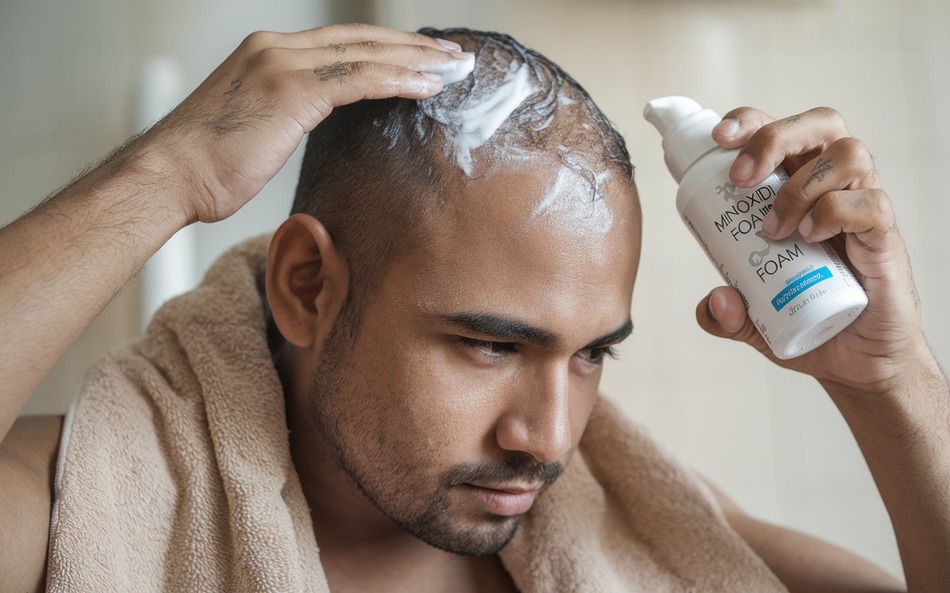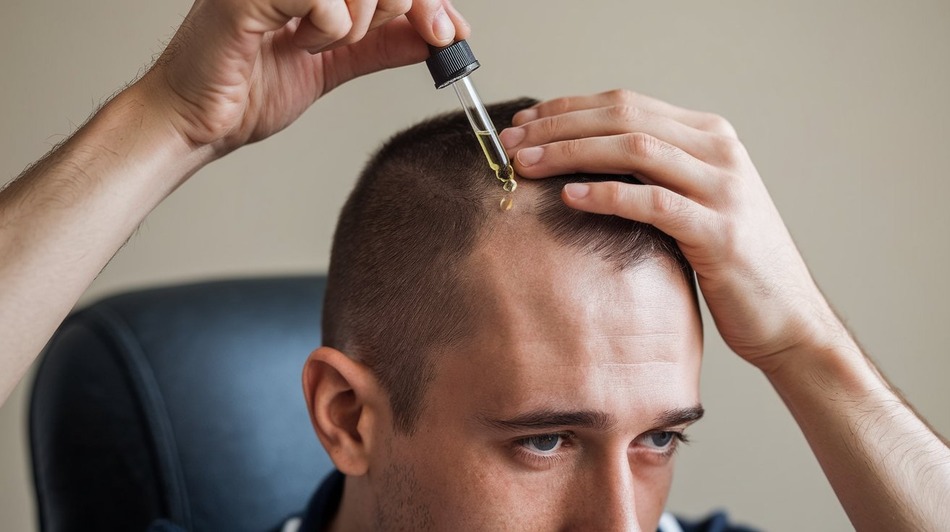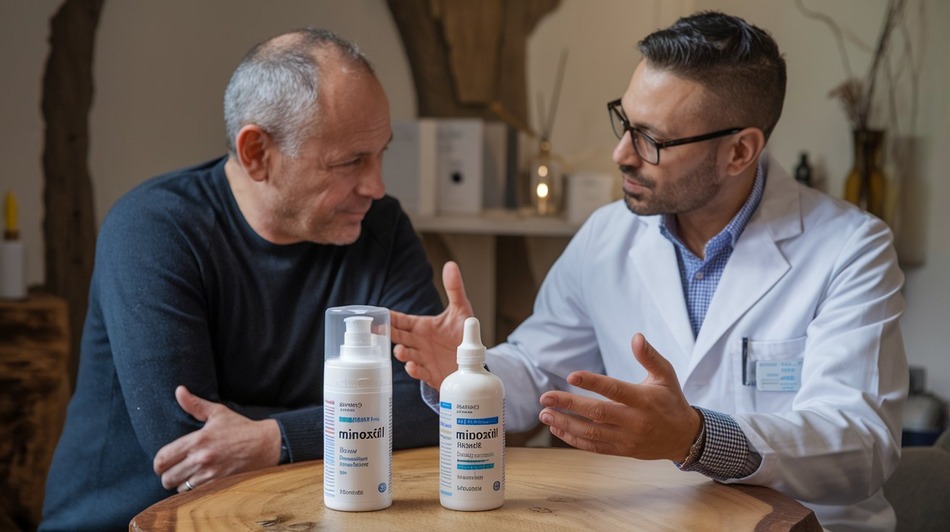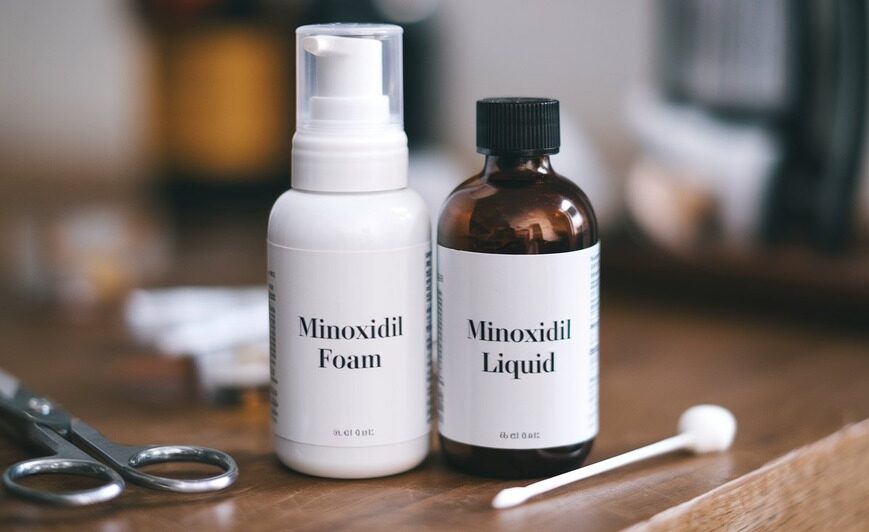Minoxidil foam vs liquid – which one’s better for my hair?
That’s the million-dollar question. When it comes to hair loss, there’s nothing more significant than Minoxidil foam and liquid. These two common approaches have distinct features that may be game-changers in certain cases. Let’s analyze whether these differences make them unique.
What is Minoxidil Foam?

Minoxidil foam is less dense and dries faster than its liquid counterpart. Many consumers consider it one of the most effective minoxidil formulations available. It is especially popular among those who experience skin issues on their scalp, as the foam does not contain propylene glycol, which can cause itching or flakiness.
Ease of Use
Using minoxidil foam is straightforward—you simply massage it onto your scalp, and that’s it. It dries quickly, making it ideal for those with little time to spend on hair care.
However, there’s a catch: If you have longer hair, you may encounter some difficulties with the application. The foam can end up resting on the top of the hair rather than penetrating the scalp, which can affect its effectiveness. This is generally not an issue for those with short hair, but it’s something to consider for individuals with longer hair.
Minoxidil Foam It’s perfect if you’re always moving. For people with hectic schedules, it is ideal because it dries more quickly.
What is Minoxidil Liquid?

Minoxidil liquid is a formula you should seriously consider, as it significantly improves scalp permeability. Being a liquid, it penetrates the skin more easily than foam and can often deliver better results. This formulation is ideal for those seeking a product that directly targets the scalp.
However, there’s a catch: the minoxidil liquid formulation is an aqueous mixture that uses propylene glycol to enhance absorption. While many users report positive results, some have experienced side effects, including irritation of the scalp, which may manifest as flakiness, itching, or redness. If you have sensitive skin, this may make the liquid version less suitable for you.
Despite these drawbacks, the liquid formulation can be advantageous, particularly for those with short hair, as it soaks in more easily. If you’re willing to tolerate some irritation for better penetration, minoxidil liquid might be the right choice for you.
Since minoxidil liquid takes longer to dry but enables more precise application, it is best suited for people who can commit to using it for a little longer.
Which Minoxidil is More Effective?
When it comes to the overall effectiveness of the two formulations, minoxidil foam and minoxidil liquid are essentially the same, as they both contain the same active ingredient. The degree of variation lies in their application and frequency of use.
While both are effective for application on the scalp, minoxidil liquid is slightly more readily absorbed—particularly beneficial if you have short hair or are applying it to areas experiencing partial baldness. On the other hand, foam is easier to apply and dries faster, which may encourage consistent use over time. Hair regrowth is a process that requires persistence and regularity, so sticking with a method you find convenient is crucial.
Yes, the liquid might absorb a bit better, but the foam’s ease of use can lead to more consistent application, which is key to seeing results. It’s not so much where the minoxidil is obtained from, but rather how faithfully you follow your treatment program that matters most.
Despite their differences, minoxidil foam and liquid are effective options for treating hair loss, although individual results may vary.
Effectiveness of Minoxidil Foam vs Liquid: Which Works Better?
User Preferences:
People often prefer minoxidil foam because it is lighter and penetrates the scalp more quickly, making it an attractive option for those who dislike the greasy feeling that many topical solutions can leave behind. In contrast, the liquid form of minoxidil is usually favoured for its ease of application, especially when only a small amount is needed. It can be applied directly to areas of thinning hair, potentially offering more effective treatment in these specific regions.
Key Considerations:
- Absorption Rate: The properties of foam allow for faster absorption, which could mean less product is wasted and that the application process is more comfortable.
- Targeting Specific Areas: The liquid form provides greater control over the application, allowing for more precise treatment of bald areas on the scalp.
Ultimately, the choice of minoxidil foam vs liquid largely depends on user preference and lifestyle. Both forms are recommended for use, enabling users to determine which option works best and delivers the most effective results for hair regrowth.
Key Differences Between Minoxidil Foam and Liquid
| Criteria | Minoxidil Foam | Minoxidil Liquid |
|---|---|---|
| Application | Quick and easy to apply. Dries fast | Takes longer to apply. Can feel messier. |
| Absorption | Slightly less efficient, especially on long hair. | Absorbs better, particularly for short hair. |
| Scalp Sensitivity | Gentler, ideal for sensitive scalps. No propylene glycol. | Contains propylene glycol, which may irritate itching or flakiness. |
| Price | More expensive due to convenience and reduced irritation. | Generally cheaper than foam |
You can easily choose the Minoxidil foam vs liquid that best suits your needs by comparing their main features side by side in this table.
How to Use Minoxidil Foam Vs Liquid: Application Techniques
| Application Technique | Minoxidil Foam | Minoxidil Liquid |
|---|---|---|
| Preparation | Shake the canister before use. | Ensure the dropper is clean and ready. |
| Amount to Apply | Apply a small amount to your fingertips. | Use the dropper to apply the desired amount directly to your scalp. |
| Application Method | Massage the foam gently into your scalp. | Spread the liquid evenly with your fingers. |
| Post-Application Care | Allow it to dry naturally; do not rinse. | Do not rinse out; let it absorb fully |
This table summarises the key application techniques for both Minoxidil foam vs liquid, making it easy to compare and follow the steps for effective use.
For optimal effects, both liquid and foam must be applied often. It is important to use the formula twice day, every day.
Minoxidil Foam vs Liquid: Which One’s Easier to Use?
If you value convenience, minoxidil foam is likely the better option for you. It is easy to apply, dries quickly, and doesn’t leave your hair feeling greasy or coated in oil. Plus, it won’t roll down your face, which can sometimes happen with the liquid form. The foam is also quite portable, making it ideal for travel or for those who prefer not to spend time massaging the product into their scalp.
On the other hand, if you have short hair or experience localized baldness—meaning certain areas are thinner than others—you might prefer the minoxidil liquid. Its formulation allows for more precise application, enabling it to penetrate the scalp better and provide improved coverage in areas that require more attention. While it may take longer to apply and set, its accuracy can be beneficial for targeting specific spots.
Foam offers convenience and speed, while liquid provides higher precision and control for localised applications.
Minoxidil Foam vs Liquid: Comparing Side Effects and Risks
When comparing minoxidil foam vs liquid, it is essential to consider the specific risks that may be associated with each formulation. Here’s what you need to know:
Common Side Effects
With both minoxidil foam vs liquid, users may experience:
- Scalp Irritation: This can manifest as redness, itching, or a burning sensation on the scalp. While generally not serious, it can be quite uncomfortable.
- Unwanted Facial Hair Growth: Some users have reported regrowth of hair in unintended areas, such as the face and neck, due to improper application of the product.
- Dizziness (Rare): Although infrequently reported, some individuals may feel dizzy after applying minoxidil. If this happens, consulting a healthcare provider is advised.
Tolerance and Observation
But don’t panic!
While some people might develop a skin rash when using minoxidil topically, this is relatively rare, and most individuals tolerate the medication well.
Here are some tips for managing side effects:
- Start Slowly: For newcomers to minoxidil, it may be beneficial to use a lower concentration of the product initially or to apply it in a diluted form to gauge your body’s response.
- Monitor Your Response: Be attentive to any changes in your scalp or overall health. If side effects become progressive or concerning, it’s best to consult a qualified doctor.
- Follow Instructions: The most effective way to minimize these risks is to adhere closely to the application instructions provided with the product.
Although both minoxidil foam vs liquid are associated with mild side effects, they typically do not cause significant discomfort for users. Ultimately, it’s a matter of finding what works best for you and understanding your body.
Cost Analysis: Minoxidil Foam Vs Liquid Pricing Comparison
Cost Analysis: Minoxidil Foam Vs Liquid Pricing Comparison
| Product Type | Average Price | Key Features | Notes |
|---|---|---|---|
| Minoxidil Foam | $37 – $50 per month | – Easy application – Quick-drying | Higher price due to convenience; often preferred for ease of use. |
| Minoxidil Liquid | $25 – $37 per month | – Precise application – Longer drying time | More budget-friendly; good for targeted treatment. |
When comparing the cost of Minoxidil Foam vs Liquid, it’s clear that foam is generally pricier due to its convenience, while the liquid form is more budget-friendly. However, remember that investing in your hair can significantly boost your confidence!
Expert Recommendations on Minoxidil Foam vs Liquid: Which to Choose?

When it comes to choosing between minoxidil foam and minoxidil liquid, experts generally recommend a practical approach:
- Try Both: Many online tutorials suggest testing both formulations to see which one is more effective for your specific case. Individual responses can vary, so personal experience is invaluable.
- Start with Foam: If you’re unsure where to begin, starting with the foam is often recommended. It is easy to use, dries quickly, and is reported to feel lighter on the scalp.
- Consider Your Lifestyle: Think about when and where you plan to use each formulation. If you prefer a quick application, the foam may be your best option. Conversely, if you want to target specific areas more precisely, the liquid may be more suitable.
Both formulations are effective, but starting with minoxidil foam might be slightly more comfortable and convenient for most people.
Don’t be afraid to try both and see what works best for you. Hair regrowth treatments are personal, and it’s important to find what fits your routine and needs.
Conclusion
When considering Minoxidil Foam vs Liquid, which is best? Both formulations are effective; the choice ultimately depends on individual preferences and specific needs. Both options promote hair regrowth, but each offers unique benefits that set them apart.
Minoxidil Foam is often preferred due to its convenience and quick absorption, making it easy to apply.
Minoxidil Liquid tends to be slightly cheaper and is recommended for targeted application in specific areas of hair loss.
Starting with the foam is advisable for those unsure about which option to choose, as many users report higher satisfaction with this method. However, trying both formulations may lead to a satisfactory outcome that aligns with your personal goals for hair restoration. As you’ve seen, taking care of your hair is a reflection of self-care.
If we compare the two formulations directly, starting with minoxidil foam is likely to be faster and easier for the majority of users.
FAQs
What is the major difference between Minoxidil foam and liquid?
The primary difference between Minoxidil foam vs liquid lies in their formulation bases; foam is pump-based, while liquid is aerosol-based. This difference affects their preparation and application. The foam version is lighter, dries faster, and is easier to use, whereas the liquid version can be directly applied to specific areas of the scalp.
Is it better to use Minoxidil foam vs liquid?
Both formulations are effective for hair regrowth, but results may vary from person to person. Some users find the foam easier to use and report faster results, while others prefer the liquid for its targeted application in specific areas.
What are the side effects of Minoxidil foam vs liquid?
Common side effects include scalp irritation, unwanted facial hair growth, and, in rare cases, dizziness. Most users tolerate both forms well, but it’s important to monitor your body’s reactions.
How should I use Minoxidil foam and liquid?
For foam, shake the canister before use. Apply the product to the palm of your hand and gently massage it into your hair and scalp. For liquid, use the dropper to apply directly to the scalp and massage gently with your fingers. Do not rinse either formulation out after application.
Does one option cost more than the other?
Overall, Minoxidil foam tends to be more expensive because it is easier to use and often perceived as more effective. In contrast, the liquid formulation is generally cheaper.
If I like both Minoxidil foam and liquid, can I apply both?
You should not use both formulations at the same time without consulting a healthcare provider. Stick to one formulation at a time to accurately assess its effects.
When does Minoxidil start working?
It typically takes about 12 weeks to notice changes, while using the product consistently for six months tends to deliver the best results. Individual experiences may vary based on factors such as the level of baldness and adherence to the treatment regimen.
Is it safe to use Minoxidil without informing my doctor?
It’s always advisable to consult your doctor if you have any chronic conditions or are taking other medications before starting a new hair loss treatment.

